A Resilience-Based Model for the Seismic Assessment of the Functionality of Road Networks Affected by Bridge Damage and Restoration
Abstract
:1. Introduction
2. Objectives and Methods
- (i)
- the hazard of the area of interest;
- (ii)
- the seismic fragility of the structures that are susceptible to earthquakes; and
- (iii)
- the exposure of the goods that are susceptible to risk.The model proposed in this study requires the definition of the road network in terms of its topology (the way nodes and links are assembled together), the position of the critical structures (in our case, bridges) and the knowledge of the relevant data required for the transportation analysis.
3. Proposed Methodology
3.1. Some Concepts of System Reliability
3.2. Flow Analysis over a Road Network
3.3. Bridge Seismic Vulnerability
3.4. Post-Earthquake Bridge Functionality
- (A)
- Pre-Earthquake: In this stage, each bridge is in full operability, and therefore no traffic restrictions have been enforced;
- (B)
- Post-Earthquake emergency: This stage represents the situation right after the seismic event. The authority in this stage may enforce very conservative restrictions on the traffic based on the state of damage of each bridge, such as: bridge closure, lane closure, restrictions to heavy vehicles, speed limitations, etc. Even the apparently undamaged bridge may require in this stage some inspection by road officials, with the presence along the bridge of men at work, equipment, and operating machines, so that some minor restrictions may been imposed such as light signals for lane control.
- (C)
- Partial Recovery: In this stage, after the completion of the first remedial works, the safety concerns can be relaxed and some of the traffic restriction imposed in the post-earthquake emergency stage can be removed.
- (D)
- Post-Recovery: In this stage, it has been assumed that bridge functionality has been restored back to the pre-earthquake levels.
4. Case Study
- (1)
- The initial state of damages (corresponding to the post-earthquake emergency) have been simulated imagining the occurrence of a medium size earthquake in the vicinity of the area object of study. The layout, in terms of link capacities, is given in Figure 3;
- (2)
- Drivers know in advance the status of congestion of the network, so that they can plan accordingly their trips (i.e., select the best path through their destination, selecting the fastest routes);
- (3)
- The analysis is carried out using the pre-earthquake OD matrix. In other words, the transportation demands are constant during all the post-earthquake phases. In this research, no attempt has been made to develop a dynamic origin-destination matrix describing the evolution with time of the transportation demand.
4.1. Damage and Restoration Analisys
4.2. Results
5. Conclusions
Author Contributions
Funding
Institutional Review Board Statement
Informed Consent Statement
Data Availability Statement
Acknowledgments
Conflicts of Interest
References
- Nuti, C.; Rasulo, A.; Vanzi, I. Seismic safety evaluation of electric power supply at urban level. Earthq. Eng. Struct. Dyn. 2007, 36, 245–263. [Google Scholar] [CrossRef]
- Nuti, C.; Rasulo, A.; Vanzi, I. Seismic safety of network structures and infrastructures. Struct. Infrastruct. Eng. Maint. Manag. Life-Cycl 2010, 6, 95–110. [Google Scholar] [CrossRef]
- Maffei, J.R. Management and prioritization of bridge seismic evaluations and upgrading. In National Seismic Conference on Bridges and Highways; Progress in Research and Practice: San Diego, CA, USA, 1995. [Google Scholar]
- Nuti, C.; Vanzi, I. Screening of bridges for assessment and retrofit. In Seismic Bridge Design and Retrofit Structural Solutions: State-of-the-Art Report, Bulletin 39; Fédération Internationale du Béton: Lausanne, Switzerland, 2007; ISBN 978-2-88394-079-6. [Google Scholar] [CrossRef]
- Gidaris, I.; Padgett, J.E.; Barbosa, A.R.; Chen, S.; Cox, D.; Webb, B.; Cerato, A. Multiple-hazard fragility and restoration models of highway bridges for regional risk and resilience assessment in the United States: State-of-the-art review. J. Struct. Eng. 2017, 143, 04016188. [Google Scholar] [CrossRef]
- Kodur, V.K.R.; Naser, M.Z. Importance factor for design of bridges against fire hazard. Eng. Struct. 2013, 54, 207–220. [Google Scholar] [CrossRef]
- Yuefei, L.; Dagang, L.; Xueping, F. Reliability updating and prediction of bridge structures based on proof loads and monitored data. Constr. Build. Mater. 2014, 66, 795–804. [Google Scholar] [CrossRef]
- Zain, M.; Usman, M.; Farooq, S.H.; Mehmood, T. Seismic vulnerability assessment of school buildings in seismic zone 4 of Pakistan. Adv. Civ. Eng. 2019, 2019, 1–14. [Google Scholar] [CrossRef] [Green Version]
- Poljansek, K.; Marín Ferrer, M.; De Groeve, T.; Clark, I. Science for Disaster Risk Management 2017: Knowing Better and Losing Less; Publications Office of the European Union: Luxembourg, Belgium, 2017. [Google Scholar]
- Bocchini, P.; Frangopol, D.M.; Ummenhofer, T.; Zinke, T. Resilience and sustainability of civil infrastructure: Toward a unified approach. J. Infrastruct. Syst. 2014, 20, 04014004. [Google Scholar] [CrossRef]
- Bruneau, M.; Chang, S.E.; Eguchi, R.T.; Lee, G.C.; O’Rourke, T.D.; Reinhorn, A.M.; Shinozuka, M.; Tierney, K.; Wallace, W.A.; von Winterfeldt, D. A framework to quantitatively assess and enhance the seismic resilience of communities. Earthq. Spectra 2003, 19, 733–752. [Google Scholar] [CrossRef] [Green Version]
- Bruneau, M.; Reinhorn, A. Exploring the concept of seismic resilience for acute care facilities. Earthq. Spectra 2007, 23, 41–62. [Google Scholar] [CrossRef] [Green Version]
- Capacci, L.; Biondini, F.; Titi, A.; Bittencourt, T.N.; Frangopol, D.M.; Beck, A. Seismic resilience of aging bridges and transportation networks. Maint. Monit. Saf. Risk Resil. Bridges Bridge Netw. 2016, 16, 266–286. [Google Scholar]
- Cimellaro, G.P.; Domaneschi, M.; Mahin, S.; Scutiero, G. Exploring simulation tools for urban seismic analysis and resilience assessment. In Proceedings of the 6th International Conference on Computational Methods in Structural Dynamics and Earthquake Engineering (COMPDYN2017), Rhodes Island, Greece, 15–17 June 2017; pp. 15–17. [Google Scholar]
- Cimellaro, G.P.; Reinhorn, A.M.; Bruneau, M. Framework for analytical quantification of disaster resilience. Eng. Struct. 2010, 32, 3639–3649. [Google Scholar] [CrossRef]
- Somy, S.; Shafaei, R.; Ramezanian, R. Resilience-based mathematical model to restore disrupted road-bridge transportation networks. Struct. Infrastruct. Eng. 2020, 1–16. [Google Scholar] [CrossRef]
- Argyroudis, S.; Selva, J.; Gehl, P.; Pitilakis, K. Systemic seismic risk assessment of road networks considering interactions with the built environment. Comput. Aided Civ. Infrastruct. Eng. 2015, 30, 524–540. [Google Scholar] [CrossRef]
- Hirokawa, N.; Osaragi, T. Earthquake Disaster Simulation System: Integration of Models for Building Collapse, Road Blockage, and Fire Spread. J. Disaster Res. 2015, 11, 2016. [Google Scholar] [CrossRef]
- Domaneschi, M.; Paolo, G.; Scutiero, G. A simplified method to assess generation of seismic debris for masonry structures. Eng. Struct. 2019, 186, 306–320. [Google Scholar] [CrossRef]
- Sediek, O.A.; El-Tawil, S.; McCormick, J. Seismic Debris Field for Collapsed RC Moment Resisting Frame Buildings. J. Struct. Eng. 2021, 147, 04021045. [Google Scholar] [CrossRef]
- Vishnu, N.; Kameshwar, S.; Padgett, J.E. A framework for resilience assessment of highway transportation networks. Paolo Gardoni (Ed.) Routledge Handb. Sustain. Resilient Infrastruct. 2018, 1, 216–238. [Google Scholar]
- Feng, K.; Li, Q.; Ellingwood, B.R. Post-earthquake modeling of transportation networks using an agent-based model. Struct. Infrastruct. Eng. 2020, 16, 1578–1592. [Google Scholar] [CrossRef] [Green Version]
- Kilanitis, I.; Sextos, A. Impact of earthquake-induced bridge damage and time evolving traffic demand on the road network resilience. J. traffic Transp. Eng. (Engl. Ed.) 2019, 6, 35–48. [Google Scholar] [CrossRef]
- Kilanitis, I.; Sextos, A.G. Integrated seismic risk and resilience assessment of roadway networks in earthquake prone areas. Bull. Earthq. Eng. 2019, 17, 181–210. [Google Scholar] [CrossRef] [Green Version]
- Padgett, J.E.; DesRoches, R. Bridge functionality relationships for improved seismic risk assessment of transportation networks. Earthq. Spectra 2007, 23, 115–130. [Google Scholar] [CrossRef]
- Grande, E.; Imbimbo, M.; Rasulo, A. Experimental Response of RC Beams Strengthened in Shear by FRP Sheets. Open Civ. Eng. J. 2013, 7, 127–135. [Google Scholar] [CrossRef]
- Rasulo, A.; Fortuna, M.A.; Borzi, B. A seismic risk model for Italy. Lect. Notes Comput. Sci. 2016, 9788, 198–213. [Google Scholar]
- Rasulo, A.; Testa, C.; Borzi, B. Seismic risk analysis at urban scale in Italy. Lect. Notes Comput. Sci. 2015, 9157, 403–414. [Google Scholar]
- Melchers, R.E.; Beck, A.T. Structural Reliability Analysis and Prediction; John Wiley & Sons Ltd. Print: Chichester, UK, 2017; ISBN 9781119265993. [Google Scholar] [CrossRef]
- Fiore, A.; Sulpizio, C.; Demartino, C.; Vanzi, I.; Biondi, S.; Fabietti, V. Seismic vulnerability assessment of historical centers at urban scale. Int. J. Archit. Herit. 2018, 12, 257–269. [Google Scholar] [CrossRef]
- Wardrop, J.G. Some Theoretical Aspects of Road Traffic Research. Proc. Inst. Civ. Eng. [CrossRef]
- Wardrop, J.G.; Whitehead, J.I. Correspondence. Some Theoretical Aspects of Road Traffic Research. ICE Proc. Eng. Div. 1952, 1, 767. [Google Scholar] [CrossRef]
- Beckmann, M.; McGuire, C.B.; Winsten, C.B. Studies in the Economics of Transportation; Yale University Press: New Haven, CT, USA, 1956; p. 232. [Google Scholar]
- U.S. Bureau of Public Roads. Traffic assignment manual for application with a large, high speed computer (Vol. 37); US Department of Commerce, Bureau of Public Roads, Office of Planning, Urban Planning Division: Washington DC, USA, 1964. [Google Scholar]
- Dantzig, G.B.; Fulkerson, D.R. On the max flow min cut theorem of networks. Linear Inequalities Relat. Syst. 2003, 38, 225–231. [Google Scholar]
- Papadimitriou, C.H.; Steiglitz, K. The Max-Flow, Min-Cut Theorem. In Combinatorial Optimization: Algorithms and Complexity; Dover Publications: Mineola, NY, USA, 1998; pp. 120–128. [Google Scholar]
- Rasulo, A.; Goretti, A.; Nuti, C. Performance of lifelines during the 2002 Molise, Italy, earthquake. Earthq. Spectra 2004, 20, 301–314. [Google Scholar] [CrossRef]
- Lavorato, D.; Fiorentino, G.; Pelle, A.; Rasulo, A.; Bergami, A.V.; Briseghella, B.; Nuti, C. A Corrosion Model for the Interpretation of Cyclic Behavior of Reinforced Concrete Sec-tions. Struct. Concrete 2019, 21, 1732–1746. [Google Scholar] [CrossRef]
- Lavorato, D.; Pelle, A.; Fiorentino, G.; Nuti, C.; Rasulo, A. A nonlinear material model of corroded rebars for seismic response of bridges. In Proceedings of the 7th ECCOMAS Thematic Conference on Computational Methods in Structural Dynamics and Earthquake Engineering (COMPDYN 2019), Crete Island, Greece, 24–26 June 2019; Papadrakakis, M., Fragiadakis, M., Eds.; pp. 24–26. [Google Scholar]
- Rasulo, A.; Pelle, A.; Lavorato, D.; Fiorentino, G.; Nuti, C.; Briseghella, B. Finite Element Analysis of Reinforced Concrete Bridge Piers including a Flexure-Shear Interaction Model. Appl. Sci. 2020, 10, 2209. [Google Scholar] [CrossRef] [Green Version]
- D’Apuzzo, M.; Evangelisti, A.; Nicolosi, V.; Rasulo, A.; Santilli, D.; Zullo, M. A Simplified Approach for the Prioritization of Bridge Stock Seismic Retrofitting. In 29th European Safety and Reliability Conference; Research Publishing: Singapore, 2019; pp. 3277–3284. [Google Scholar]
- D’Apuzzo, M.; Evangelisti, A.; Nicolosi, V.; Rasulo, A. Simplified approach to integrate seismic retrofitting prioritization with social cost evaluation: A case study in central Italy. J. Traffic Transp. Eng. (Engl. Ed.) 2021, in press. Available online: https://kns.cnki.net/kcms/detail/61.1494.U.20210514.1426.002.html (accessed on 13 July 2021).
- Azevedo, J.; Guerreiro, L.; Bento, R.; Lopes, M.; Proença, J. Seismic vulnerability of lifelines in the greater Lisbon area. Bull. Earthq. Eng. 2010, 8, 157–180. [Google Scholar] [CrossRef]

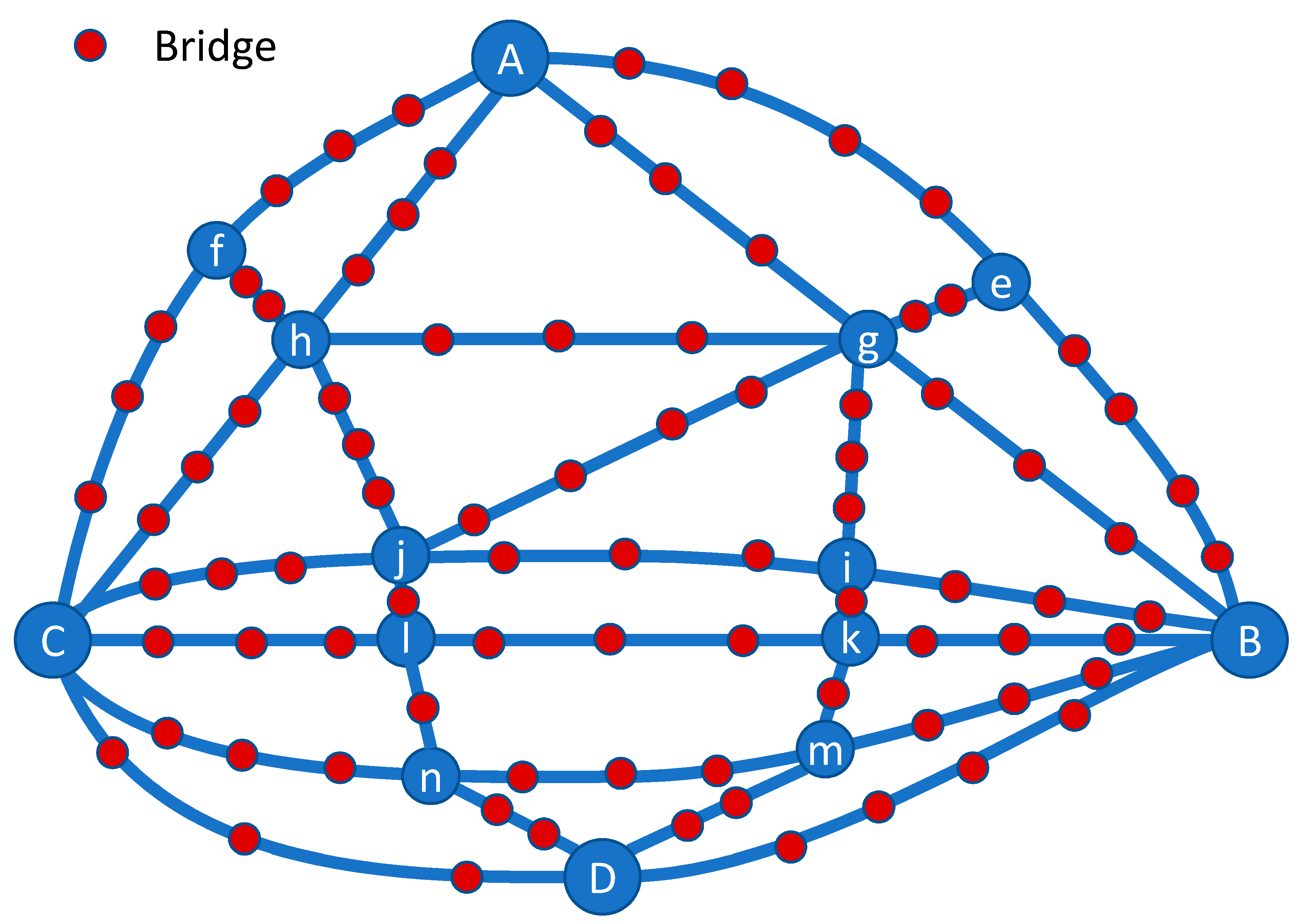
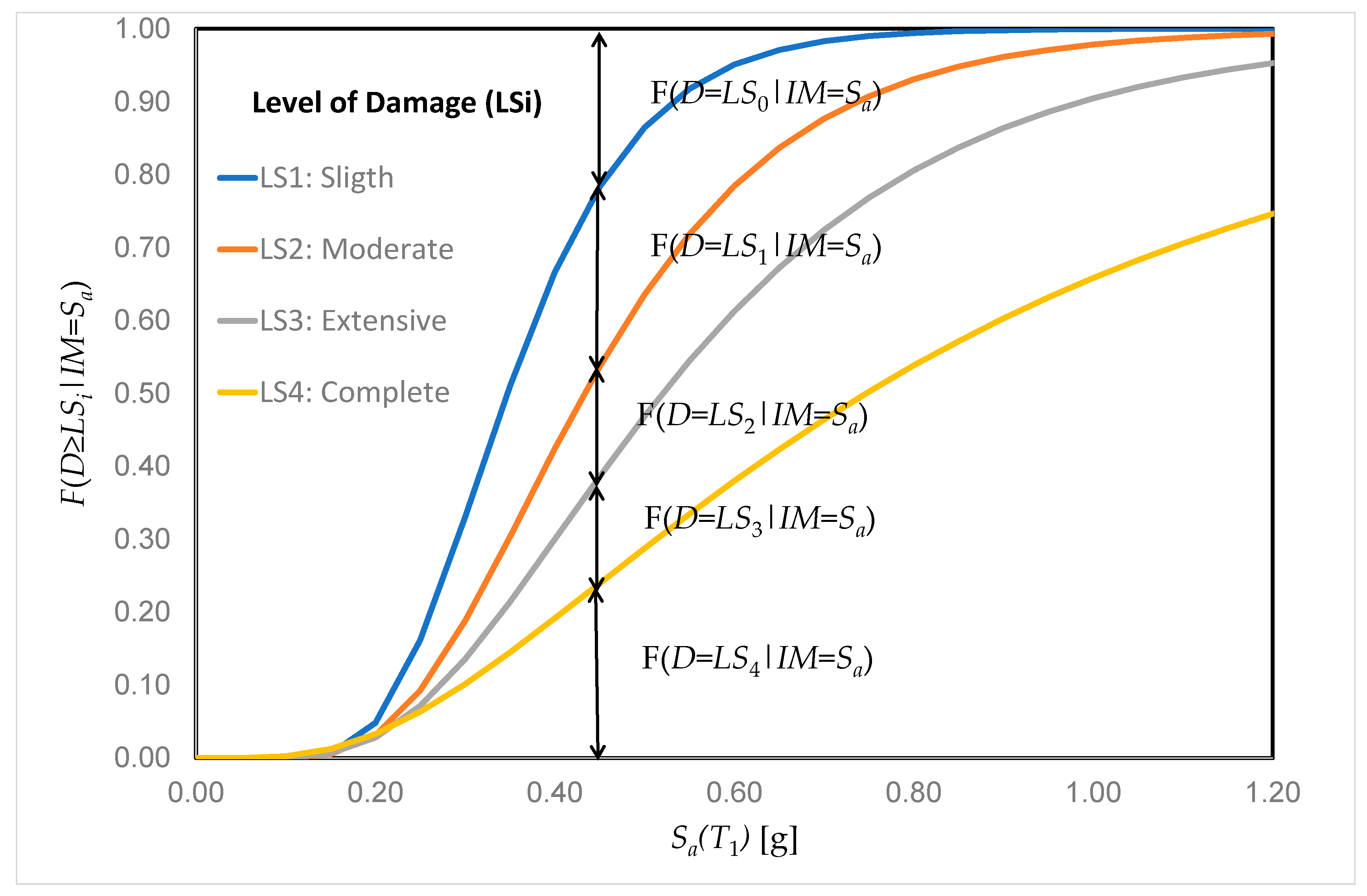
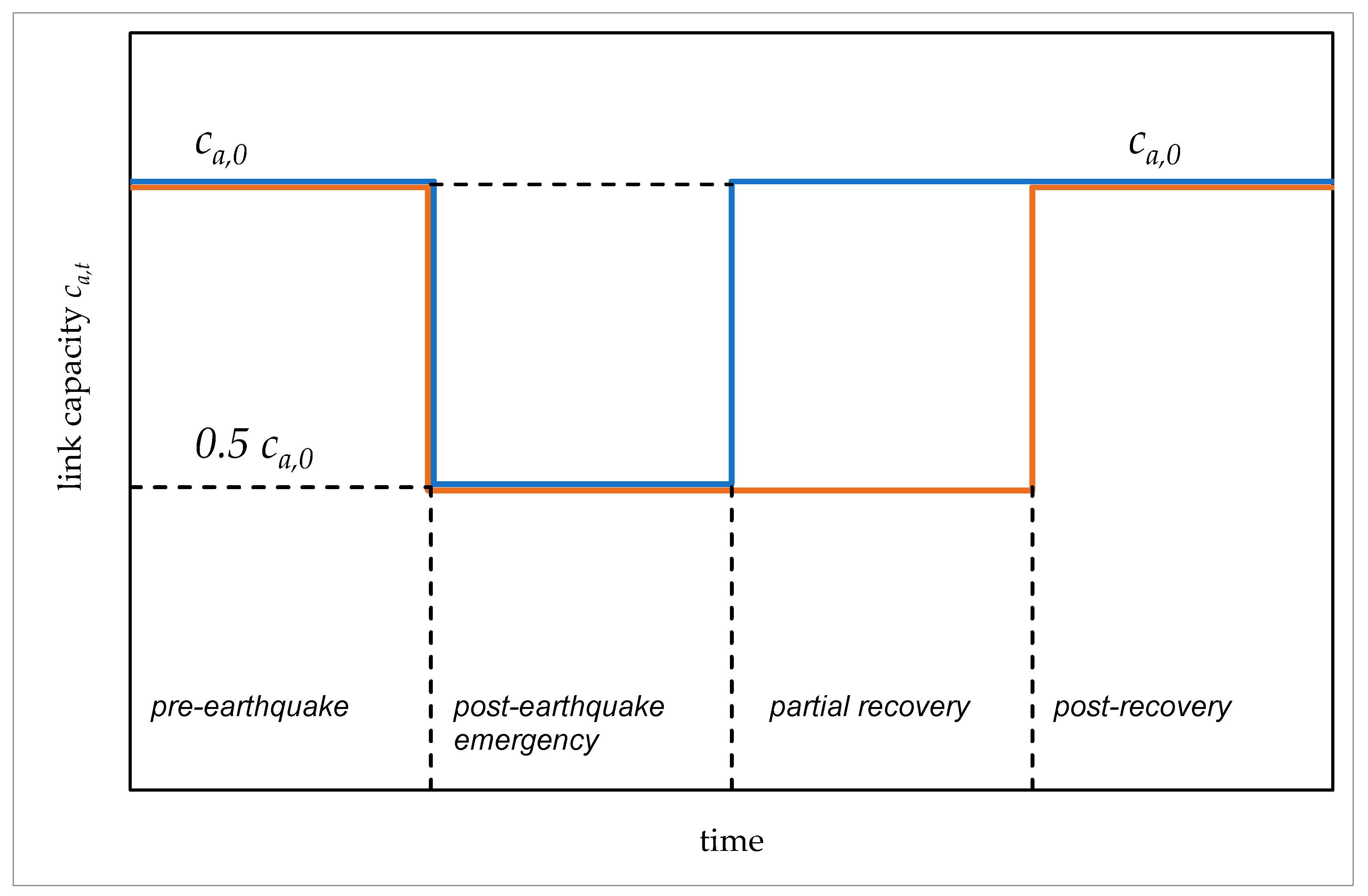
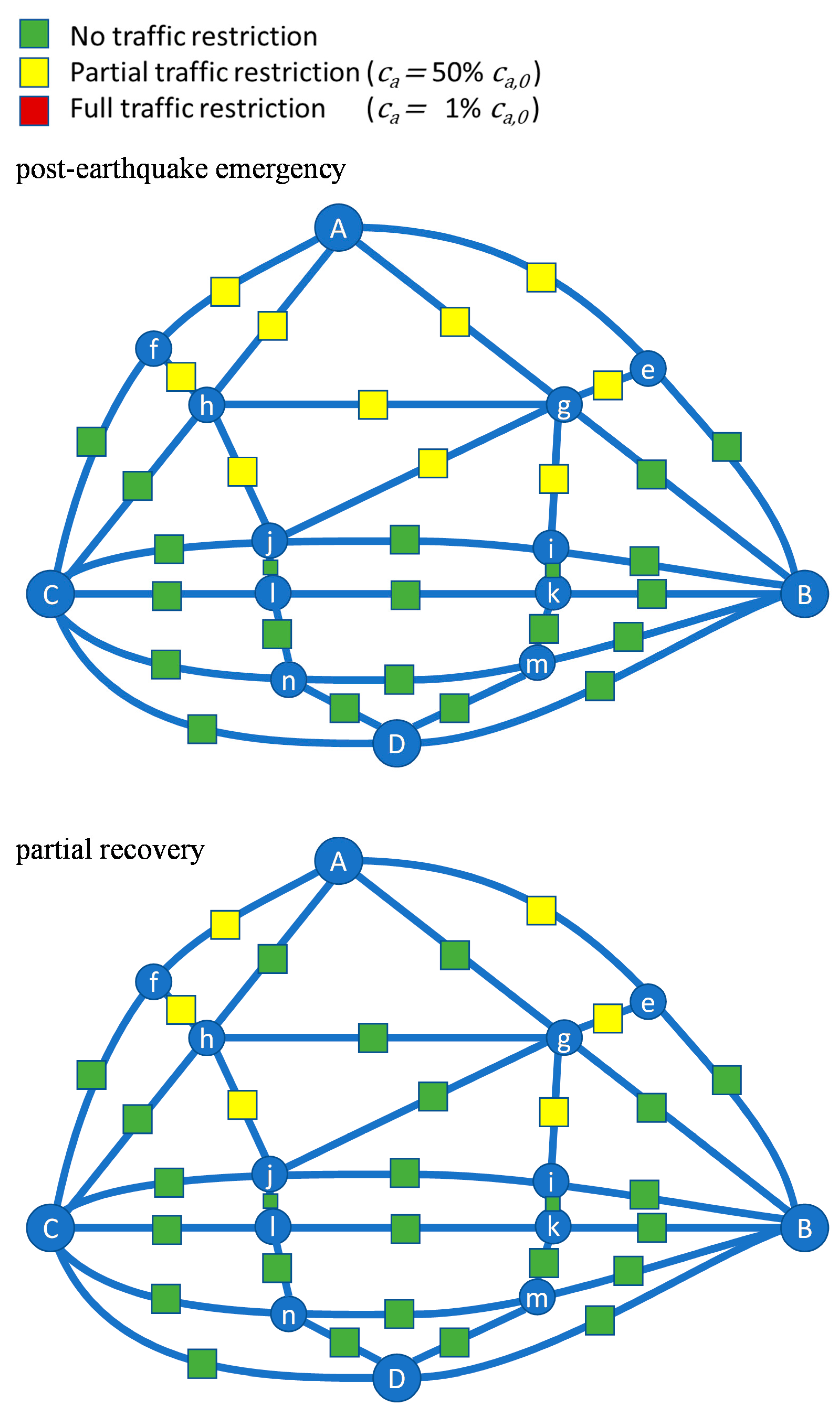
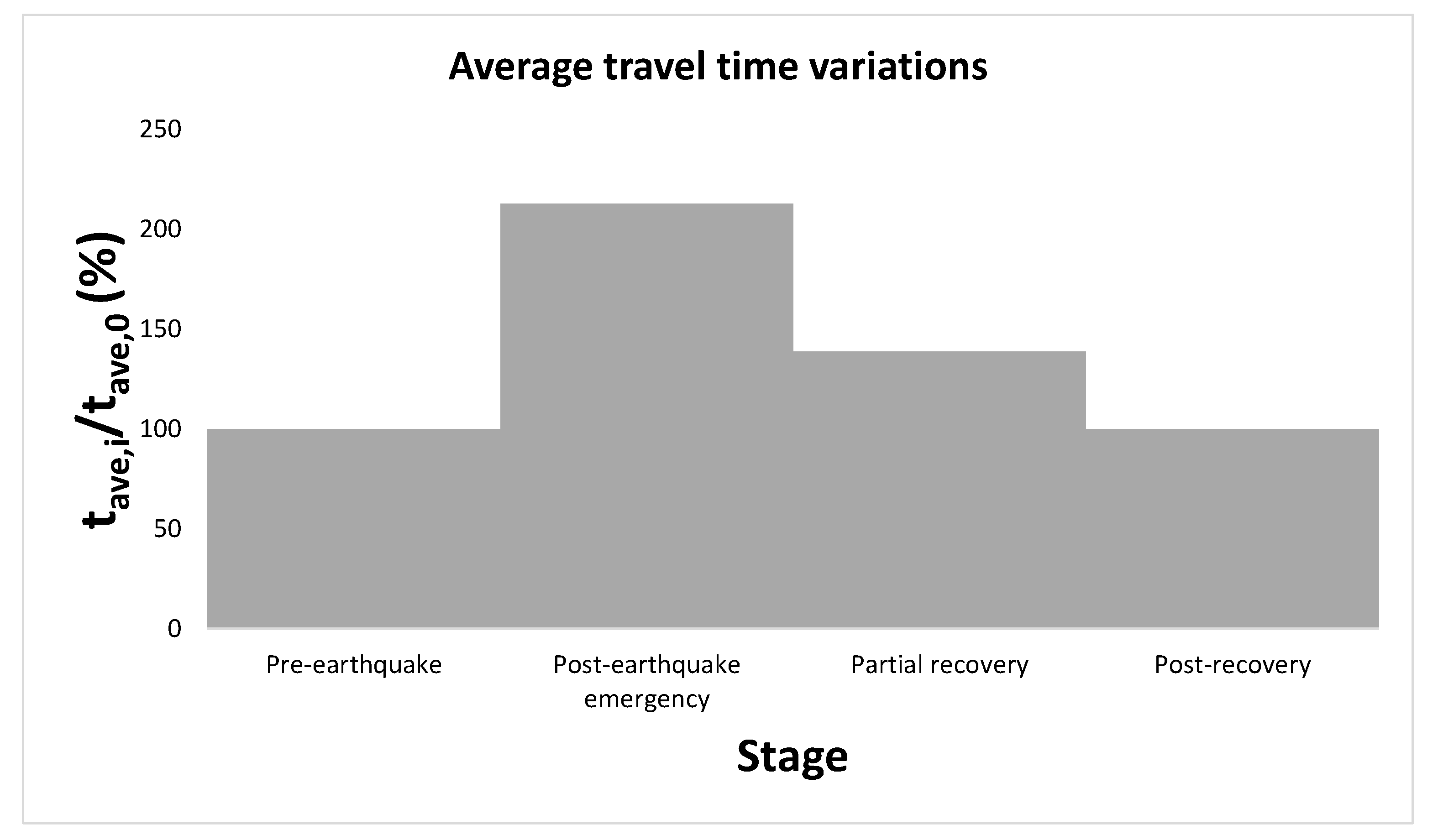
| Link | La (km) | vo,a (km/h) | ca (Veich/Day) |
|---|---|---|---|
| A–e | 15.0 | 80 | 3000 |
| A–f | 15.0 | 80 | 3000 |
| A–g | 15.0 | 110 | 4000 |
| A–h | 15.0 | 110 | 4000 |
| B–D | 25.0 | 80 | 3000 |
| B–e | 15.0 | 80 | 3000 |
| B–g | 15.0 | 110 | 4000 |
| B–i | 15.0 | 70 | 2000 |
| B–k | 15.0 | 130 | 6000 |
| B–m | 15.0 | 70 | 2000 |
| C–D | 25.0 | 80 | 3000 |
| C–f | 15.0 | 50 | 1000 |
| C–h | 15.0 | 110 | 4000 |
| C–j | 15.0 | 70 | 2000 |
| C–l | 15.0 | 130 | 6000 |
| C–n | 15.0 | 70 | 2000 |
| D–m | 10.0 | 70 | 2000 |
| D–n | 10.0 | 70 | 2000 |
| e–g | 5.0 | 50 | 1000 |
| g–h | 15.0 | 50 | 1000 |
| f–h | 5.0 | 50 | 1000 |
| g–i | 15.0 | 50 | 1000 |
| g–j | 15.0 | 50 | 1000 |
| i–j | 15.0 | 70 | 2000 |
| h–j | 15.0 | 50 | 1000 |
| i–k | 2.0 | 70 | 2000 |
| j–l | 2.0 | 70 | 2000 |
| k–l | 15.0 | 130 | 6000 |
| k–m | 2.0 | 70 | 2000 |
| l–n | 2.0 | 70 | 2000 |
| m–n | 10.0 | 70 | 2000 |
| Origin/Destination | A | B | C | D | Tot. |
|---|---|---|---|---|---|
| A | ---- | 1500 | 2500 | 1000 | 5000 |
| B | 1500 | ---- | 2500 | 1000 | 5000 |
| C | 2500 | 2500 | ---- | 1000 | 6000 |
| D | 1000 | 1000 | 1000 | ---- | 3000 |
| Tot. | 5000 | 5000 | 6000 | 3000 |
Publisher’s Note: MDPI stays neutral with regard to jurisdictional claims in published maps and institutional affiliations. |
© 2021 by the authors. Licensee MDPI, Basel, Switzerland. This article is an open access article distributed under the terms and conditions of the Creative Commons Attribution (CC BY) license (https://creativecommons.org/licenses/by/4.0/).
Share and Cite
Rasulo, A.; Pelle, A.; Briseghella, B.; Nuti, C. A Resilience-Based Model for the Seismic Assessment of the Functionality of Road Networks Affected by Bridge Damage and Restoration. Infrastructures 2021, 6, 112. https://doi.org/10.3390/infrastructures6080112
Rasulo A, Pelle A, Briseghella B, Nuti C. A Resilience-Based Model for the Seismic Assessment of the Functionality of Road Networks Affected by Bridge Damage and Restoration. Infrastructures. 2021; 6(8):112. https://doi.org/10.3390/infrastructures6080112
Chicago/Turabian StyleRasulo, Alessandro, Angelo Pelle, Bruno Briseghella, and Camillo Nuti. 2021. "A Resilience-Based Model for the Seismic Assessment of the Functionality of Road Networks Affected by Bridge Damage and Restoration" Infrastructures 6, no. 8: 112. https://doi.org/10.3390/infrastructures6080112
APA StyleRasulo, A., Pelle, A., Briseghella, B., & Nuti, C. (2021). A Resilience-Based Model for the Seismic Assessment of the Functionality of Road Networks Affected by Bridge Damage and Restoration. Infrastructures, 6(8), 112. https://doi.org/10.3390/infrastructures6080112








